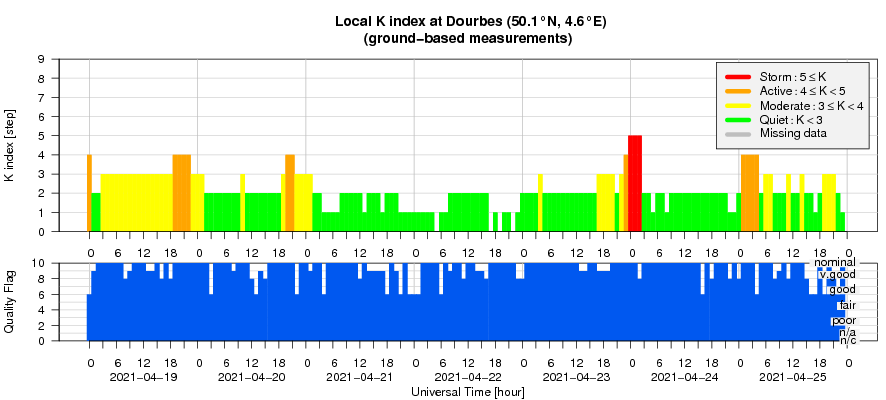- Table of Content
- 1.Kees de Jager ...
- 2.M1 flare!
- 3.Review of sola...
- 4.PROBA2 Observa...
- 5.The Internatio...
- 6.Review of geom...
- 7.Geomagnetic Ob...
- 8.The SIDC Space...
- 9.Review of iono...
- 10.STCE in Action...
2. M1 flare!
3. Review of solar activity
4. PROBA2 Observations
5. The International Sunspot Number by Silso
6. Review of geomagnetic activity
7. Geomagnetic Observations at Dourbes
8. The SIDC Space Weather Briefing
9. Review of ionospheric activity (19 Apr 2021 - 25 Apr 2021)
10. STCE in Action: upcoming events
Kees de Jager 100!
In honour of the 100th Birtday of Kees de Jager, prominent Dutch astronomer and one of our favorite solar physicists, the EUI instrument onboard Solar Orbiter took a pair of images in two different wavelengths. The images were taken in the very early morning of April 29, at 00:19:21 and 00:20:21 CEST representing the years 1921 and 2021. These two images were sent back to earth with high priority, travelling over 135 million kilometers through our solar system as low-latency telemetry, when they were collected by the New Norcia Station in Australia which is part of the ESA deep space network. Via the Solar Orbiter Mission Operations Centre in Darmstadt in Germany, the data finally arrived at the EUI Data Centre at the Royal Observatory of Belgium from where the EUI instrument was commanded and all images sent by the satellite to Earth are processed such that scientists can work with them.
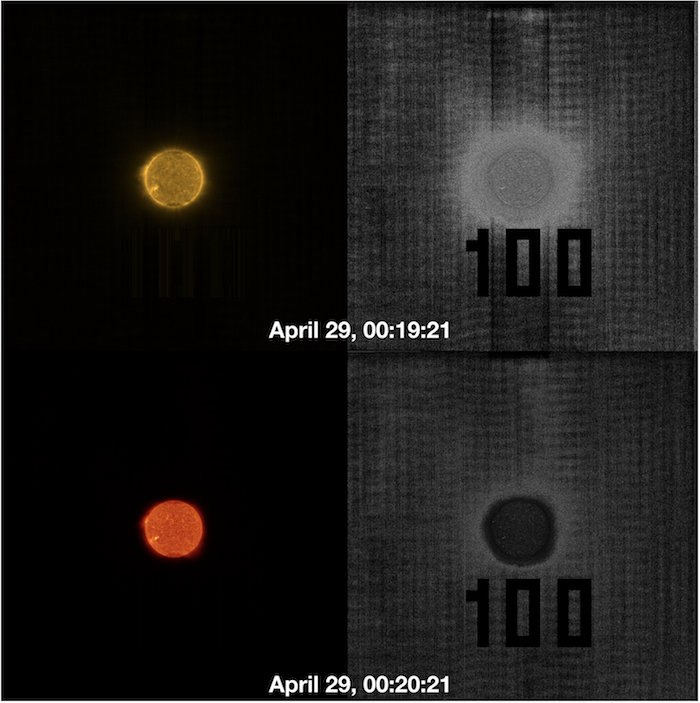
At first glance, as pretty as these images are, they look like what we expect. But by cleverly making use of a feature that is typically used to help calibrate the images on-board, the EUI team commanded their instrument to include a watermark inside these two images. When filtering these images for vertical features, the watermark ‘100’ clearly becomes visible.
While preparing this birthday card, our bad pixel correction functionality became fully commissioned :-)
Kees, we wish you a Happy Birthday at the speed of light, 100 % supported by Solar Orbiter and EUI. You witnessed 9 solar cycles, passing smoothly to your 10th.
We loved your participation in 'De Kennis van nu' and your enthusiasm and support for Solar Orbiter.
Happy Birthday!
M1 flare!
NOAA 2816 was an all-in-all relatively simple sunspot group when, on 19 April 2021, it produced an M1 flare. The source of the flare was located in the trailing portion of the sunspot group, where there was some mixing of magnetic polarities. Some coronal dimming and a weak coronal wave were observed in extreme ultraviolet imagery, telltale signs that a coronal mass ejection (CME) was associated with this event. Coronagraphic imagery revealed indeed the presence of a CME, but it had no earth-directed component.
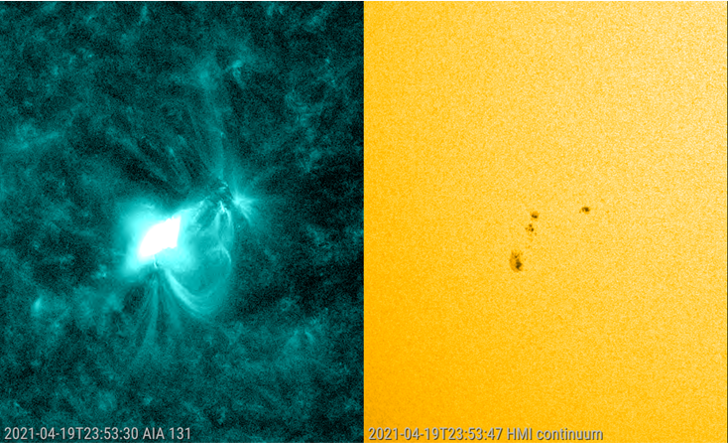
Following the M-class flares of 29 May and 29 November last year, this is only the 3rd event of such a class so far this solar cycle (SC25). In comparison with the previous solar cycle (SC24), SC25 had a spurt in the sunspot number (Sn , http://sidc.be/silso/ ) in November last year, but that resulted in only 1 M-class flare (see the graph underneath). In SC24, we had a significant increase in the sunspot number during the January-February 2010 timeframe (months 13-14 in the graph), accompanied by no less than 15 M-class flares. For SC25, one can expect a gradual increase in sunspot number and M-class flares as 2021 further develops. If SC25 is anything similar to the previous solar cycle, then X-class flares can be expected from 2022 onwards, but it can occur sooner following the unanticipated emergence of a flare-active sunspot group. One very active group: that's all it takes!
Note: The SC25 flare data have not been rescaled. See the NOAA bulletin for more information at https://www.swpc.noaa.gov/news/goes-14-15-are-now-storage-mode
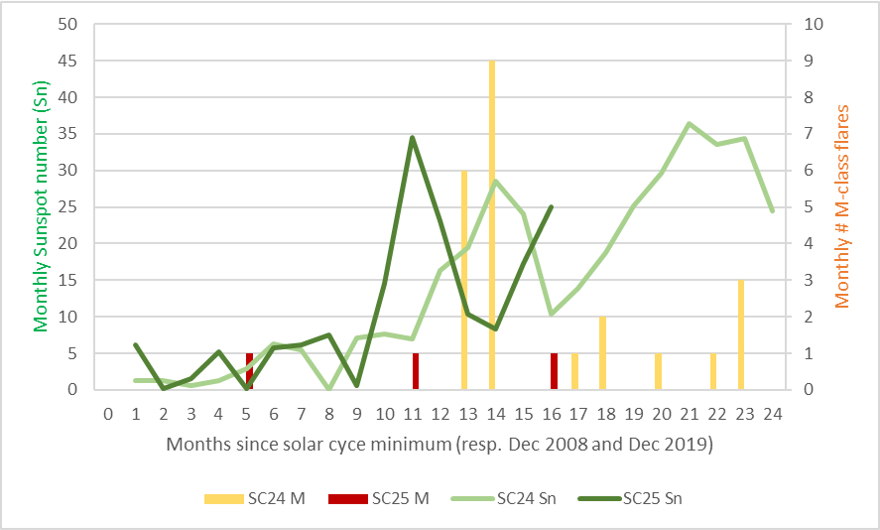
Review of solar activity
Seven numbered active regions were observed on the side of the solar disk facing Earth: NOAA AR 2814, 2815, 2817, 2818, 2819 and 2820. GOES measured 1 M-class flare, 20 C-class flares and numerous B-class flares.
The largest reported flare was an M1.1 flare observed on April 19 (peaked at 23:42 UT) which originated from the Catania sunspot group 87 (NOAA AR 2816). The flare was associated with an EUV wave, coronal dimming, type II radio burst and rather diffuse CME.
Two wide CMEs were reported this week.
The diffuse CME associated with the M1.1 flare had the angular width of about 100 degrees and projected line of sight speed of 500 km/s. The CME propagated through space between STEREO A and Earth. The source region was situated close to the solar disc center.
The other CME was associated with the C3.8 flare (peaked at 04:35 UT on April 22) that originated from the Catania sunspot group 87 (NOAA AR 2816) which was at that moment situated at the center of the solar disc. The CME was Earth directed. The faint partial halo CME was first seen in the SOHO LASCO C2 field of view at 6:12 UT on April 22. The CME had angular width of about 160 degrees and a projected line of sight speed of about 450 km/s.
A small, negative polarity equatorial coronal hole reached the central meridian in the morning of April 20.
The greater than 2MeV electron flux was mostly above the 1000 pfu threshold, while the 24h electron fluence was mostly at moderate level with a few moderate to high periods.
PROBA2 Observations
Solar Activity
Solar flare activity fluctuated from moderate to very low during the week.
In order to view the activity of this week in more detail, we suggest to go to the following website from which all the daily (normal and difference) movies can be accessed: https://proba2.oma.be/ssa
This page also lists the recorded flaring events.
A weekly overview movie can be found here (SWAP week 578): https://proba2.sidc.be/swap/data/mpg/movies/weekly_movies/weekly_movie_2021_04_19.mp4
Details about some of this week's events can be found further below.
If any of the linked movies are unavailable they can be found in the P2SC movie repository here: https://proba2.oma.be/swap/data/mpg/movies/
Monday Apr 19
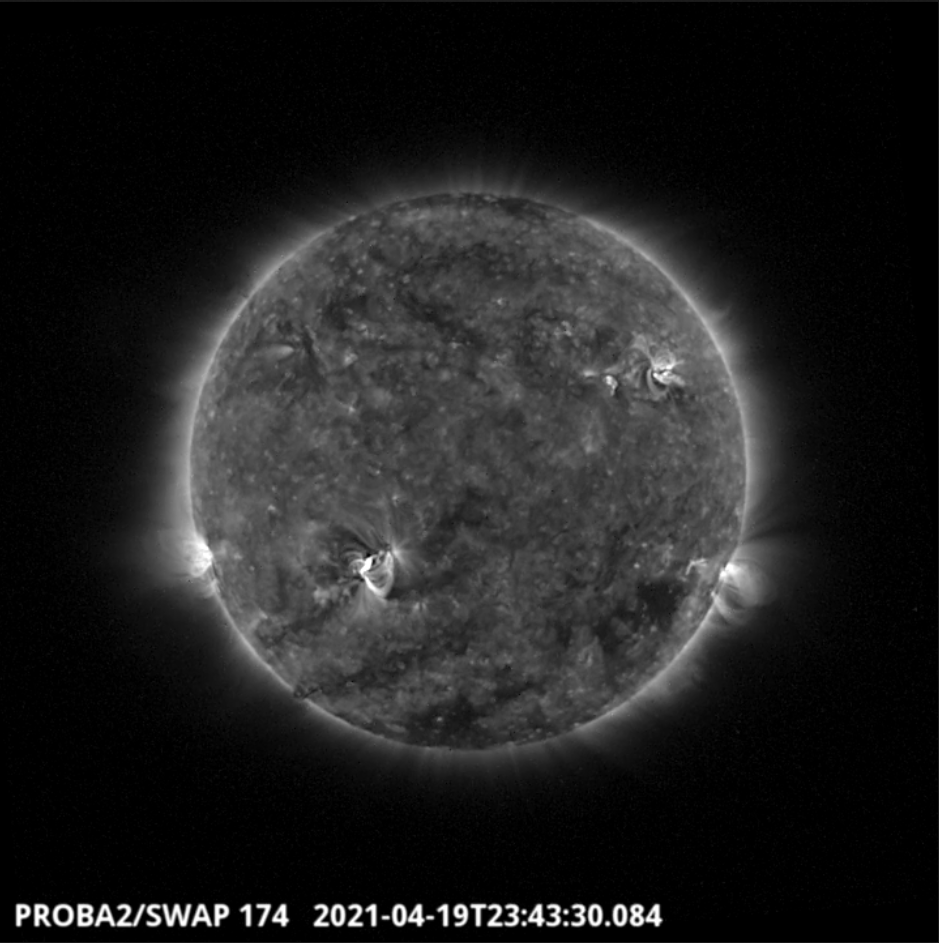
The largest flare of the week, an M1.1 flare associated with NOAA Active region 2816, was observed by SWAP and LYRA on 2021-Apr-19. The flare occurred in the south-eastern quadrant of the solar disk, as shown in the SWAP image above taken at 23:43 UT.
Find a movie of the event here (SWAP movie): https://proba2.sidc.be/swap/movies/20210419_swap_movie.mp4
The International Sunspot Number by Silso
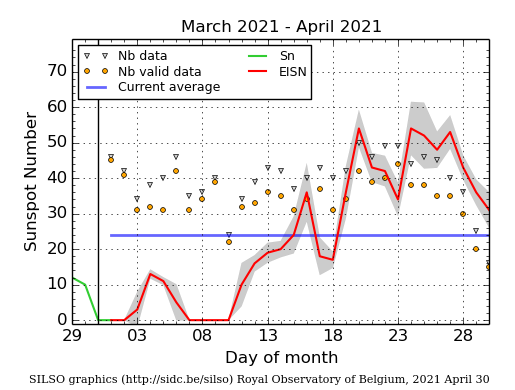
The daily Estimated International Sunspot Number (EISN, red curve with shaded error) derived by a simplified method from real-time data from the worldwide SILSO network. It extends the official Sunspot Number from the full processing of the preceding month (green line), a few days more than one solar rotation. The horizontal blue line shows the current monthly average. The yellow dots gives the number of stations that provided valid data. Valid data are used to calculate the EISN. The triangle gives the number of stations providing data. When a triangle and a yellow dot coincide, it means that all the data is used to calculate the EISN of that day.
Review of geomagnetic activity
The first three days of the week, Earth was inside a fast solar wind regime (speed up to 650 km/s), which decreased to 400 km/s in the evening of April 22. The fast solar wind was associated with the southern polar coronal hole which extended towards the solar equator.
The in situ observations at L1 indicated the arrival of the solar wind originating from the small, negative polarity equatorial coronal hole (reached the central meridian in the morning of April 20), in the evening of April 23. The density increased at that time, followed by the increase of the interplanetary magnetic field magnitude, solar wind temperature and speed. The phi angle was predominantly negative.
A shock passed the L1 point at 22:27 UT on April 24. The strength of interplanetary magnetic field increased from 5 to 10 nT. Together with this sudden change, the solar wind density, velocity and temperature increased. The shock wave was driven by the partial halo CME of April 22.
The fast solar wind observed in the first three days of the week induced few intervals of active geomagnetic conditions (Kp=4 and K=4, reported by Dourbes and NOAA respectively).
The solar wind associated with the small equatorial coronal hole (with the Bz component of the interplanetary magnetic field as low as -8 nT) induced active geomagnetic conditions. The local station at Dourbes and NOAA reported K and Kp equals 5 late on April 23, early on April 24.
The shock wave associated with the April 22 CME induced disturbed geomagnetic conditions (Kp=4 and K=5, reported by Dourbes and NOAA respectively) on April 25.
The SIDC Space Weather Briefing
The Space Weather Briefing presented by the forecaster on duty from April 18 to 25. It reflects in images and graphs what is written in the Solar and Geomagnetic Activity report.

A pdf-version: https://www.stce.be/briefings/20210426_SWbriefing.pdf
The movie: https://www.stce.be/briefings/20210426_SWbriefing.m4v
Review of ionospheric activity (19 Apr 2021 - 25 Apr 2021)
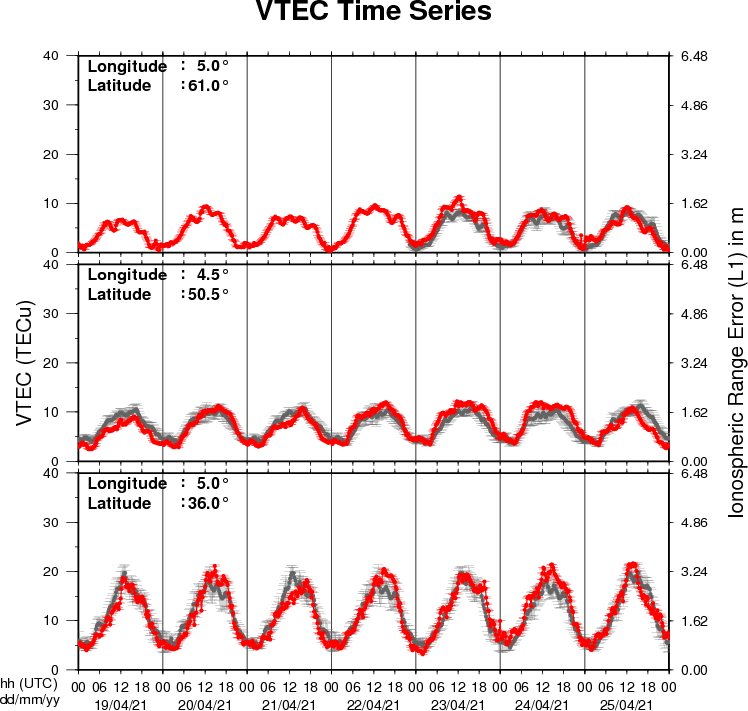
The figure shows the time evolution of the Vertical Total Electron Content (VTEC) (in red) during the last week at three locations:
a) in the northern part of Europe(N61�, 5�E)
b) above Brussels(N50.5�, 4.5�E)
c) in the southern part of Europe(N36�, 5�E)
This figure also shows (in grey) the normal ionospheric behaviour expected based on the median VTEC from the 15 previous days.
The VTEC is expressed in TECu (with TECu=10^16 electrons per square meter) and is directly related to the signal propagation delay due to the ionosphere (in figure: delay on GPS L1 frequency).
The Sun's radiation ionizes the Earth's upper atmosphere, the ionosphere, located from about 60km to 1000km above the Earth's surface.The ionization process in the ionosphere produces ions and free electrons. These electrons perturb the propagation of the GNSS (Global Navigation Satellite System) signals by inducing a so-called ionospheric delay.
See http://stce.be/newsletter/GNSS_final.pdf for some more explanations ; for detailed information, see http://gnss.be/ionosphere_tutorial.php
STCE in Action: upcoming events
Check out our activity calendar: activities and encounters with space weather as main theme. We provide occasions to get submerged in the space weather world through educational, informative and instructive activities.
Due to COVID, these activities and events are organised online.
May 5 - seminar: High energy electron flux in the radiation belts
May 17,18,20,21: SWx introductory course (registration is open)
Details on: https://www.stce.be/calendar

